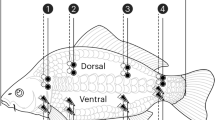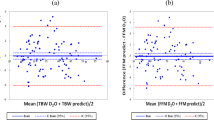Abstract
BACKGROUND: Bioelectrical-impedance spectroscopy (BIS) is a very attractive method for body composition measurements in a clinical setting. However, validation studies often yield different results. This can partly be explained by the different approaches used to transform measured resistance values into body compartments.
OBJECTIVE: The aim of this study was to compare the linear regression (LR) method with the Hanai Mixture theory (HM). Secondly, the effect of degree of overweight on the accuracy of BIS was analysed.
DESIGN: In 90 people (10 M, 80 F; body mass index (BMI) 23–62 kg/m2) total body water (TBW) and extracellular water (ECW) were measured by deuterium and NaBr dilution methods, respectively, and by BIS. Resistance values of ECW (RECW) and TBW (RTBW) were used for volume calculations. Data of half the group were used for LR based on L2/R (L=length, R=resistance) to predict TBW and ECW and to calculate the constants used in the HM (kECW), kp). Prediction equations and constants were cross-validated in Group 2.
RESULTS: Bland and Altman analysis showed that the LR method underestimated TBW by 1.1 l (P<0.005) and ECW by 1.1 l (P<0.005). The HM approach underestimated ECW by 0.8 l (P<0.005). The correlations with the dilution methods and the SEEs for TBW and ECW were comparable for the two approaches. The prediction error of BIS for TBW and ECW correlated with BMI. The constant kECW, and the specific resistivities of the ECW and intracellular water (ICW) PECW and PICW were also correlated with BMI.
CONCLUSIONS: The mixture approach is slightly more accurate than linear regression, but not sensitive enough for clinical use. The constants used in the HM model are not constants in a population with a wide variation in degree of overweight. The physical causes of the correlation between BMI and constants used in the model should be studied further in order to optimize the mixture model.
This is a preview of subscription content, access via your institution
Access options
Subscribe to this journal
Receive 12 print issues and online access
$259.00 per year
only $21.58 per issue
Buy this article
- Purchase on Springer Link
- Instant access to full article PDF
Prices may be subject to local taxes which are calculated during checkout






Similar content being viewed by others
References
Foster KR, Lukaski HC . Whole-body impedance—what does it measure? Am J Clin Nutr 1996 64 (Suppl): 388S–96S.
Nyboer J . Electrorheometric properties of tissues and fluids Ann NY Acad Sci 1970 170: 410–420.
Kushner RF . Bioelectrical impedance analysis: a review of principles and applications J Am Col Nutr 1992 11: 199–209.
Brodie D, Moscrip V, Hutcheon R . Body composition measurements: A review of hydrodensitometry, anthropometry and impedance methods Nutrition 1998 14: 296–310.
Plank LD, Monk DN, Woollard GA, Hill GL . Evaluation of multifrequency bioimpedance spectroscopy for measurement of the extracellular water space in critically ill patients Appl Radiat Isot 1998 49: 481–483.
Deurenberg P, Schouten FJM, Andreoli A, de Lorenzo A . Assessment of changes in extracellular water and total body water using multi-frequency bio-electrical impedance. In: Ellis KJ, Eastman JD (eds) Human Body Composition: Vivo Methods, Models and Assessment. Plenum: New York, 1993 pp 129–132.
Hannan WJ, Cowen SJ, Fearon KCH, Plester CE, Falconer JS, Richardson RA . Evaluation of multi-frequency bioimpedance analysis for the assessment of extracellular and total body water in surgical patients Clin Sci 1994 86: 479–485.
Deurenberg P, Tagliabue A, Schouten FJM . Multi-frequency impedance for the prediction of extracellular water and total body water Br J Nutr 1995 73: 349–358.
Chumlea WC, Guo SS, Baumgartner RN, Siervogel RM . Determination of body fluid compartments with multiple frequency bioelectric impedance. In: Ellis KJ, Eastman JD (eds) Human Body Composition: Vivo Methods, Models and Assessment. Plenum: New York, 1993 pp 23–26.
Van Loan MD, Mayclin PL . Use of multi-frequency bioelectrical impedance analysis for the estimation of extracellular fluid Eur J Clin Nutr 1992 46: 117–124.
Deurenberg P, Schouten FJM . Loss of total body water and extracellular water assessed by multifrequency impedance Eur J Clin Nutr 1992 46: 247–255.
Baarends EM, Van Marken Lichrenbelt WC, Wouters EFM, Schols AMWJ . Body-water compartments measured by bio-electrical impedance spectroscopy in patients with chronic obstructive pulmonary disease Eur J Clin Nutr 1998 17: 15–22.
Van Marken Lichtenbelt W, Westerterp KR, Wouters L, Luijendijk SCM . Validation of bioelectrical-impedance measurements as a method to estimate body-water compartments Am J Clin Nutr 1994 60: 159–166.
Hanai T . Electrical properties of emulsions. In: Sherman PH (ed) Emulsion science. Academic: London, 1968 pp 354–477.
Van Load MD, Kopp LE, King JC, Wong WW, Mayclin PL . Fluid changes during pregnancy: use of bioimpedance spectroscopy J Appl Physiol 1995 78 (3): 1037–1042.
Jaffrin MY, Maasrani M, Le Gourrier A, Boudailliez B . Extra- and intracellular volume monitoring by impedance during haemodialysis using Cole–Cole extrapolation Med Biol Eng Comput 1997 35: 266–270.
Ho LT, Kushner RF, Schoeller DA, Gudivaka R, Spiegel DM . Bioimpedance analysis of total body water in hemodialysis patients Kidney Int 1994 46: 1438–1442.
Patel RV, Matthie JR, Withers PO, Peterson EL, Zarowitz BJ . Estimation of total and extracellular water using single- and multiple-frequency bioimpedance Ann Pharmacother 1994 28: 565–569.
Lorenzo de A, Andreoli A, Matthie J, Withers P . Predicting body cell mass with bioimpedance methods: a technological review J Appl Physiol 1997 82 (5): 1542–1558.
Van Loan MD, Withhers P, Matthie J, Mayclin PL . Use of bioimpedance spectroscopy to determine extracellular fluid, total body water, and fat-free. In: Ellis KJ, Eastman JD (eds) Human Body Composition: In Vivo Methods Models and Assessment. Plenum: New York, 1993 pp 67–70.
van Marken Lichtenbelt WD, Snel YEM, Brummer RJM, Koppeschaar HPF . Deuterium and Bromide Dilution, and Bioimpedance Spectrometry independently show that growth hormone-deficient adults have an enlarged extracellular water compartment related to intracellular water J Clin Endocrinol Metab 1997 82: 907–911.
Hemsfield SB, Wang Z, Visser M, Gallagher D, Pierson RN . Techniques used in the measurement of body composition: an overview with emphasis on bioelectrical impedance analysis Am J Clin Nutr 1996 64 (Suppl): 478S–484S.
Lukaski HC, Johnson PE, Bolonchuk WW, Lykken GI . Assessment of fat free mass using bioelectrical impedance measurement of human body Am J Clin Nutr 1985 41: 810–817.
Lukaski HC . Biological indexes considered in the derivation of the bioelectrical impedance analysis Am J Clin Nutr 1996 64 (Suppl): 397S–404S.
Westerterp KR, Wouters L, van Marken Lichtenbelt WD . The Maastricht protocol for the measurement of body composition and energy expenditure with labeled water Obes Res 1995 3 (Suppl 1): 49–57.
Wong WW, Sheng HP, Morkeberg JC, Kosanovich JL, Clarke LL, Klein PD . Measurement of extracellular water volume by bromide ion chromatography Am J Clin Nutr 1989 50: 1290–1294.
Bland JM, Altman DG . Statistical methods for assessing agreement between two methods of clinical measurements Lancet 1986 1: 307–310.
Cornish BH, Ward LC, Thomas BJ . Measurement of extracellular and total body water of rays using multiple frequency bioelectrical impedance analysis Nutr Res 1992 12: 657–666.
Deurenberg P . Limitations of the bioelectrical impedance method for the assessment of body fat in severe obesity Am J Clin Nutr 1996 64 (Suppl): 449S–4452S.
Heitman BL . Impedance: A valid method in assessment of body composition? Eur J Clin Nutr 1994 48: 228–240.
Ward LC, Elia M, Cornish BH . Potential errors in the application of mixture theory to multifrequency bioelectrical impedance analysis Physiol Meas 1998 19: 53–60.
Chumlea WC, Baumgartner RN . Bioelectrical impedance methods for the estimation of body composition Can J Spt Sci 1990 15 (3): 172–179.
Chumlea WC, Shumei SG . Bioelectrical impedance and body composition Present status and future directions Nutr Rev 1994 52: 123–131.
Fuller NJ, Elia M . Potential use of bioelectrical impedance of the whole body and of body segments for the assessment of body composition: comparison with densitometry and anthropometry Eur J Clin Nur 1989 43: 779–791.
Azcue M, Wesson D, Neuman M, Pencharz P . What does bioelectrical impedance spectroscopy (BIS) measure? In: Ellis KJ, Eastman JD (eds) Human Body Composition: Vivo Methods, Models and Assessment. Plenum: New York, 1993 pp 67–70.
Pierson RN, Wang J, Colt EW, Neumann P . Body composition measurements in normal man: The potassium, sodium, sulfate and tritium spaces in 58 adults J Chronic Dis 1982 35:: 419–428.
Scharfetter H, Wirnsberger GH, Holzer H, Hutten H . Influence of ionic shifts during dialysis on volume estimations with multifrequency impedance analysis Med & Biol Eng & Comput 1997 35: 96–102.
Ellis KJ, Wong WW . Human hydrometry: comparison of multifrequency bioelectrical impedance with 2H2O and bromide dilution J Appl Physiol 1998 85: 1056–1062.
Author information
Authors and Affiliations
Corresponding author
Rights and permissions
About this article
Cite this article
Cox-Reijven, P., Soeters, P. Validation of bio-impedance spectroscopy: Effects of degree of obesity and ways of calculating volumes from measured resistance values. Int J Obes 24, 271–280 (2000). https://doi.org/10.1038/sj.ijo.0801123
Received:
Revised:
Accepted:
Published:
Issue Date:
DOI: https://doi.org/10.1038/sj.ijo.0801123
Keywords
This article is cited by
-
RETRACTED ARTICLE: Predictive analysis of identification and disease condition monitoring using bioimpedance data
Journal of Ambient Intelligence and Humanized Computing (2021)
-
Validity of multi-frequency bioelectric impedance methods to measure body composition in obese patients: a systematic review
International Journal of Obesity (2019)
-
Prediction of body water compartments in preterm infants by bioelectrical impedance spectroscopy
European Journal of Clinical Nutrition (2013)
-
Body composition in athletes and sports nutrition: an examination of the bioimpedance analysis technique
European Journal of Clinical Nutrition (2013)
-
Evaluation of body composition: why and how?
Mediterranean Journal of Nutrition and Metabolism (2009)



